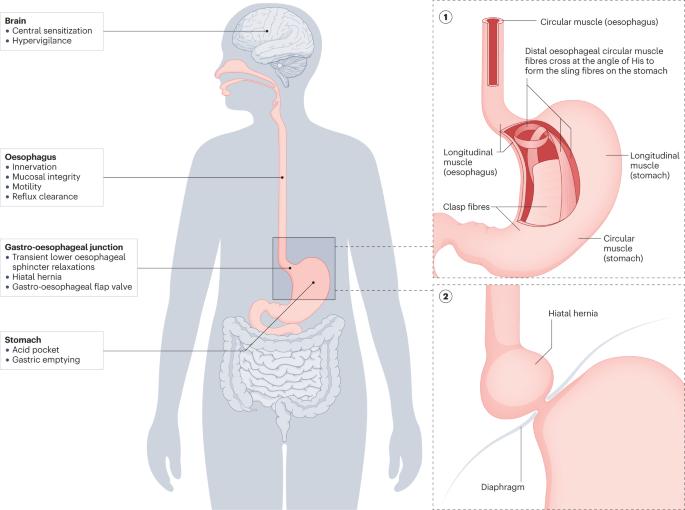胃食管反流病的病理生理学:对诊断和管理的影响
IF 45.9
1区 医学
Q1 GASTROENTEROLOGY & HEPATOLOGY
引用次数: 0
摘要
胃食管反流病(GERD)是一种常见的胃肠道疾病,胃内容物逆流进入食管会引起不适症状和/或并发症。它的病理生理学是由多种因素造成的,目前尚不完全清楚。胃食管反流病始于胃部,反流物在胃部产生。按照反流的轨迹,抗反流屏障(主要是下食道括约肌和嵴膈)失效,使反流物到达食道腔,引发食道或食道外症状。原发性和继发性蠕动等反流清除机制以及富含碳酸氢盐的唾液对防止粘膜损伤至关重要。食道粘膜完整性的改变,如宏观食道炎或微观变化,决定了对症状的感知。症状的强度受外周和中枢神经及心理机制的影响。在这篇综述中,我们描述了对胃食管反流病复杂的多因素病理生理学的最新认识。现在人们认识到,不同的胃食管反流病表型具有不同的反流程度、粘膜完整性损伤的严重程度和类型以及症状的严重程度。这些差异可能是由于每个患者都存在一种主要的病理生理机制。我们还描述了胃食管反流病的主要病理生理机制及其对个性化诊断和管理的影响。本文章由计算机程序翻译,如有差异,请以英文原文为准。


Pathophysiology of gastro-oesophageal reflux disease: implications for diagnosis and management
Gastro-oesophageal reflux disease (GERD) is a common gastrointestinal disorder in which retrograde flow of gastric content into the oesophagus causes uncomfortable symptoms and/or complications. It has a multifactorial and partially understood pathophysiology. GERD starts in the stomach, where the refluxate material is produced. Following the trajectory of reflux, the failure of the antireflux barrier, primarily the lower oesophageal sphincter and the crural diaphragm, enables the refluxate to reach the oesophageal lumen, triggering oesophageal or extra-oesophageal symptoms. Reflux clearance mechanisms such as primary and secondary peristalsis and the arrival of bicarbonate-rich saliva are critical to prevent mucosal damage. Alterations of the oesophageal mucosal integrity, such as macroscopic oesophagitis or microscopic changes, determine the perception of symptoms. The intensity of the symptoms is affected by peripheral and central neural and psychological mechanisms. In this Review, we describe an updated understanding of the complex and multifactorial pathophysiology of GERD. It is now recognized that different GERD phenotypes have different degrees of reflux, severity of mucosal integrity damage and type, and severity of symptoms. These variations are probably due to the occurrence of a predominant pathophysiological mechanism in each patient. We also describe the main pathophysiological mechanisms of GERD and their implications for personalized diagnosis and management. In this Review, Argüero and Sifrim describe the core pathophysiological mechanisms involved in gastro-oesophageal reflux disease (GERD). They also discuss the implications for clinical management of GERD.
求助全文
通过发布文献求助,成功后即可免费获取论文全文。
去求助
来源期刊
CiteScore
52.30
自引率
0.60%
发文量
147
审稿时长
6-12 weeks
期刊介绍:
Nature Reviews Gastroenterology & Hepatology aims to serve as the leading resource for Reviews and commentaries within the scientific and medical communities it caters to. The journal strives to maintain authority, accessibility, and clarity in its published articles, which are complemented by easily understandable figures, tables, and other display items. Dedicated to providing exceptional service to authors, referees, and readers, the editorial team works diligently to maximize the usefulness and impact of each publication.
The journal encompasses a wide range of content types, including Research Highlights, News & Views, Comments, Reviews, Perspectives, and Consensus Statements, all pertinent to gastroenterologists and hepatologists. With its broad scope, Nature Reviews Gastroenterology & Hepatology ensures that its articles reach a diverse audience, aiming for the widest possible dissemination of valuable information.
Nature Reviews Gastroenterology & Hepatology is part of the Nature Reviews portfolio of journals.

 求助内容:
求助内容: 应助结果提醒方式:
应助结果提醒方式:


